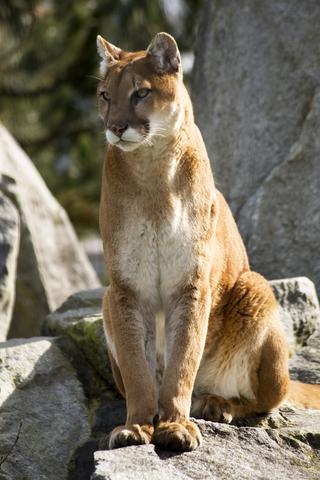

In addition to its' excellent vision, the Mountain Lion has extremely sensitive hearing. Although Mountain Lions cannot see in complete darkness, they can discern details in much lower light than humans. The animal's eyes are quite large, and the retina contains more rods than cones, lending to the cat's excellent night vision. The vision of the Mountain Lion is one of the animal's most important adaptations for hunting. Mountain Lion habitat must provide an adequate prey base as well as cover for hunting. Human activity has encouraged Mountain Lions to retreat to the rugged terrain that remains largely uninhabited by humans. Mountain Lions can survive in a variety of habitats, including high mountains, deserts, and swamps. Variations in the color of the lion's coat have been listed as rust, apricot, lemon, smoke, and even black. The underside of the cat is white, and the tail is tipped in black. The coat of the Mountain Lion is light brown in color, and the fur is short and coarse. The largest Mountain Lion ever to be documented weighed 276 pounds, but a Lion of this size is extremely rare. Mountain Lions usually weigh between 75-175 pounds. The tail of the Mountain Lion is about one-third the entire length of the body. These large cats, as adults, can be 30 inches in height at the shoulder, and approximately 8 feet long from nose to tail. So unexpected that it's common for people to initially mistake them for deer even though the only things deer and Mountain Lions have in common are four legs and similar colored fur. Sighting a wild Mountain Lion is a rare and unexpected event. These majestic creatures once roamed throughout North America, but today, their range is limited to British Columbia and Alberta, Canada, the twelve westernmost states in the US, and Florida. Starving Cougar Attacks Vernal Man, Hans Moran, Deseret News Nov.Also known as cougar, puma, panther, yellow cat, catamount, etc., the Mountain Lion is North America's largest member of the cat family. Mountain Lion, Wildlife Notebook, Utah Division of Wildlife Resources,


Images: Courtesy USDA and US FWS Digital Library Thanks to the Rocky Mountain Power Foundation for supporting the development of this Wild About Utah program.įor Wild About Utah and Stokes Nature Center, I’m Holly Strand. If you live near mountains or rocky cliff areas keep a close eye on children and pets especially at dusk and dawn. Make yourself look as big as possible by raising your arms up high. Its instinct is to chase running animals. First of all, don’t run from or turn your back to a mountain lion. Nevertheless, they can kill people and with wildlife-human confrontations on the increase it’s good to know what to do if you meet one of these big kitties. Mountain lion attacks are extremely rare and there have been no deaths from them in Utah. They usually know where you are before you know where they are, so they can easily avoid human contact. They are extremely secretive and largely nocturnal. Photographer: Larry MoatsĪlthough they are found everywhere in the state, the animals are rarely seen. According to the Division of Wildlife Resources, the only place in Utah they’re not found is in the salt flats west of the Great Salt Lake. Nowadays, In the United States, it is now mainly restricted to remote areas in the western part of the country including in Utah. The mountain lion, or cougar as it is often called, was once the most widely distributed mammal in the Americas. Undoubtedly that’s what attracted my morning visitor. In winter our yard is a mountain lion pantry, plentifully stocked with live mule deer steaks browsing on our trees. Given the size, the color, the time of day, and the way it moved, I’m pretty sure that I saw a mountain lion. Dogs don’t “melt” as a method of locomotion. As I reached the window I got a brief glimpse of the animal as it melted away into a large ravine. I raced upstairs to get a better view from the second floor window. I continued to watch the backyard visitor but it was very still and hard to see. I’ve never seen a large dog like that in this neighborhood. Something moved and my eyes focused on a large dog-sized animal half hidden and crouched behind some rabbit brush.

One cold dawn in January I glanced out the kitchen window at the snow-covered yard. Hi, I’m Holly Strand from Stokes Nature Center in beautiful Logan Canyon.
#Utah mountain lion download#
Download file | Play in new window | Duration: 3:07 | Recorded on March 4, 2010


 0 kommentar(er)
0 kommentar(er)
